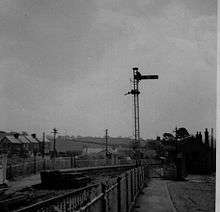Instow


Instow is a village in north Devon, England. It is on the estuary where the rivers Taw and Torridge meet, between the villages of Westleigh and Yelland and on the opposite bank of Appledore. There is an electoral ward with the same name. Its total population at the 2011 census was 1,501.[1]
There is a small river beach and sand dunes, that home some rare species of orchid including the pyramid orchid.[2]
The Tarka Trail passes through Instow, providing an easy means for people to arrive by foot or on bike. This section of the Trail is also part of the South West Coast Path, offering longer walks along the coast.
Instow Railway Station
The line opened from Barnstaple to Fremington in 1848, and then passenger trains ran from Barnstaple to Bideford from 2 November 1855 after the Bideford Extension Railway. The line was further extended to Torrington in 1872. Passenger services ceased on 2 October 1965 although ball clay traffic continued until 1982. The track was finally removed in 1985.
Instow has a famous railway signal box, which is over 130 years old and was the UK's first Grade 2 Listed signal box. It used to control the signals at Instow Station and also the operation of the level crossing. You can see the wheel that operated the gates, pull the signal levers, one of which still operates a signal, and generally learn how the box worked. In 2003 the box was nationally recognised for its restoration and educational value by receiving the Carillion Rail Award at the National Railway Heritage Awards. The signal box is now managed and run by volunteers of the Bideford Railway Heritage Centre and is open to the public on occasional Sundays and Bank Holidays.
Admission is free but donations to help with the upkeep of the box are gladly accepted. Follow the Tarka Trail to Bideford and visit Bideford Station as well.
Instow Beach
Instow Beach also known as Instow Sands, is used widely during summer months at the peak of the tourist season. The beach is suitable for families as it enjoys few waves because of the sandbanks at the mouth of the estuary cancelling out most of the ocean swell. However, bathing water quality has regularly failed Environment Agency mandatory standards over the last few decades.[3][4]

There is a large number of boats anchored on the sand. Many are only accessible at low-tide or via a dinghy or what is locally known as a tender. Windsurfing and kite surfing have become popular, taking advantage of the open position and calm waters. Canoeing and kayaking in the rivers to Instow beach is also popular.
A fire-crew from nearby Bideford were called to attend a fire on the sand dunes on the afternoon of Sunday 7 March 2010. Firemen beat out the flames, watched by a small crowd of onlookers, although large parts of the grass were burnt before it was brought under control.
Arromanches Camp
Near the village is Arromanches Camp which is operated by the Royal Marines, the main unit which uses the camp is No. 11 (Amphibious Trials and Training) Squadron.
Notable people
- John Harmer (1857–1944), Bishop of Rochester, died in Instow
- Leonard Slater (1875-1914), English cricketer and British Army officer
- John Durnford-Slater (1909-1972), British Army officer credited with raising the first Army commando unit during the Second World War
- David Shepherd (1940-2009), English cricketer and umpire[5]
- Norah Simpson (1895–1974), Australian modernist artist, died at Crossways, Instow.[6]
Instow features prominently in the 1919 novel Last of the Grenvilles by Frederick Harcourt Kitchin (under his pseudonym, Bennett Copplestone)
Bus services
Instow is served by frequent Stagecoach services 21/21A between Ilfracombe, Barnstaple, Bideford and Westward Ho!/Appledore daily. These connect at Barnstaple with trains to Exeter and buses towards Exeter and Tiverton and at Bideford with buses towards Okehampton, Holsworthy and Hartland. Instow is also served by Stagecoach service 5B between Barnstaple, Bideford, Torrington, Winleigh, Crediton and Exeter and National Express coach services to London, Heathrow Airport, Taunton, Bristol and Birmingham.
Ferry service
During summer a ferry service operates across the Torridge estuary from Instow Quay to Appledore slipway. The service runs two hours either side of high tide. Aimed both at locals and users of the Tarka Trail / South West Coast Path this has been operated in recent times as a not-for-profit service on days when water levels in the estuary have been high enough.
References
- ↑ "Ward population 2011.Retrieved 21 Feb 2015".
- ↑ "Sand Dunes" (PDF). North Devon District Council. p. 1. Retrieved 1 September 2009.
- ↑ "Bathing water quality". Environment Agency. 15 October 2012.
- ↑ "Instow Beach Bathing Water Profile" (PDF). Environment Agency. February 2011.
- ↑ "Shepherd prepares for last dance". Daily Mail. 11 July 2005.
- ↑ Gray, Anne (7 May 2012). "Norah Simpson: Biography". Design and Art Australia Online. Retrieved 30 October 2012.
External links
| Wikimedia Commons has media related to Instow. |
Coordinates: 51°03′N 4°10′W / 51.050°N 4.167°W
